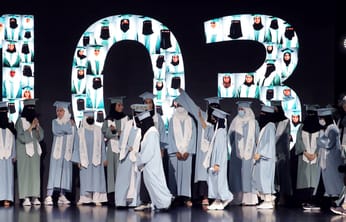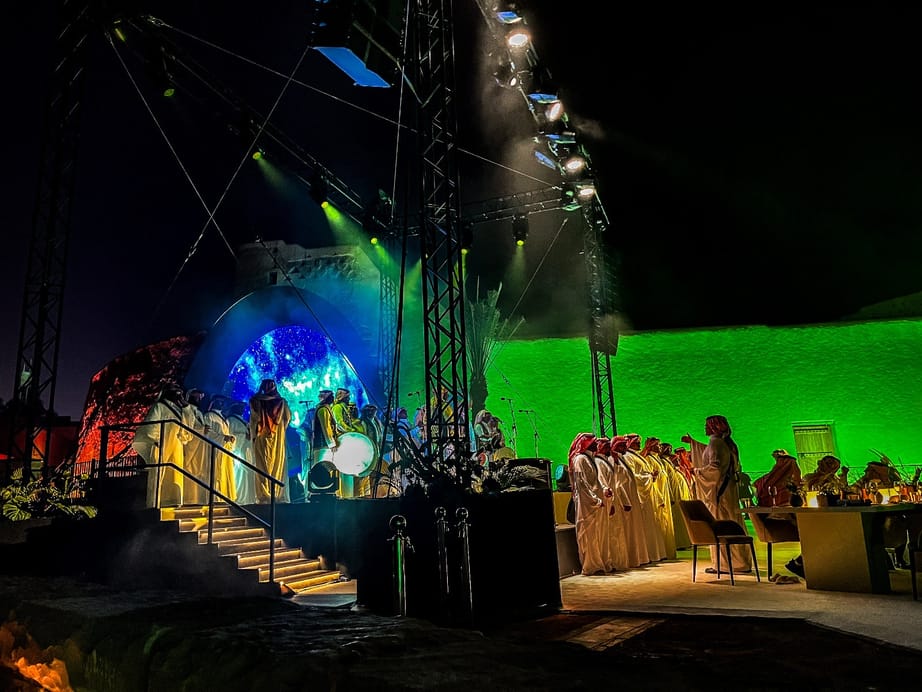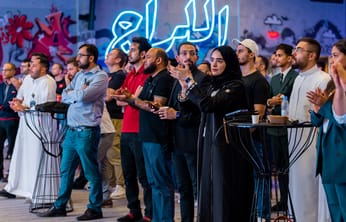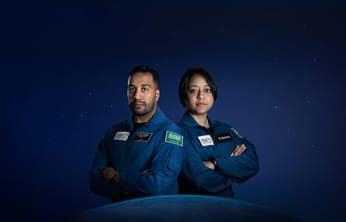
Leading The Charge
With education, mentorship, collaborations, and more, here’s how Saudi Arabia is attempting to close the gender gap in AI

Harnessing the power of digital twins to reimagine cities across the KSA and beyond.
According to PwC’s 2022 report, How Digital Twins Can Make Smart Cities Better, a digital twin is -in its simplest sense- “a linked virtual model of a physical object.” To explain it better, here’s PwC Middle East Technology Consultant Partner Kaveh Vesalli. “A digital twin is a virtual model of a physical object, person, place, or process that can be used to simulate or imitate its behavior to better understand how it would work in real life,” he says. “It collects data from the built and natural environments, along with human and machine activity, via technologies such as sensors, drones, and mobile devices. Armed with the right data, models, and process governance, digital twins are the most analytically sophisticated yet visually intuitive design and decision support systems available today.”
One of the areas where digital twins are playing a big role in is in the realm of urban planning. Cities all around the world are expanding, and this is even more true in the Middle East, specifically Saudi Arabia, where its ambitious urban development projects are backed by a vision to do more than merely build infrastructure. Rather, it’s a vision that involves creating a host of smart cities- which means cities that anticipate and cater to the needs of its inhabitants, leveraging technology to do so.
The Digit Group is a US-based real estate development company specializing in urban solutions, and its CEO and President Paul Doherty has played an instrumental role in smart cities around the world (including in China and Australia), and he has also worked on the blueprint that was used in Saudi Arabia’s Vision 2030. Doherty is insistent about the importance of using the right words in the context of digital twins, and adds that, with the advances of technology in his lifetime, going from hand drawing to the digital context, “we’re in a whole new world.”
“We like to call digital twins a mirror of what is reality,” he says. “That’s really good for communicating design intent for construction. But then we start to look at what else it can do, beyond just being a communications vehicle, to a constructor to build something. We’re looking at technologies that can sit underneath those geometries that allow us to explore different designs and simulations of how people are going to interface with it. It’s no longer a digital twin, but we’re looking at it now as a virtual world. You can attach different types of experiences around it. We are now no longer about the level of detail (LOD)- we’re now responsible for the level of experience.”
But this is only the beginning, Doherty says. “Now, things start to become really interesting, because when you have that level of experience, you have the opportunity to pull together these virtual worlds, and when they all start to communicate together, you then have your neighborhood,” he explains. “You now have your square block. You have your district, you have your city. When all of those start talking together, that’s when we start calling it the Metaverse. What I’m finding in places like NEOM, Qiddiya, Red Sea Global, and all these mega projects inside the Kingdom is that the light bulbs are going off, which means that the outcome will be a better built environment.”
This feeds into the upcoming projects in Saudi Arabia, where sustainability has been the forefront of the Kingdom’s vision. PwC’s Vesalli underscores the role of digital twins in realizing this worthy goal by pointing out that the Kingdom is currently working towards building and developing four major cities: the technologically advanced and sustainable NEOM, the culturally centered Al Ula, also one of the world’s oldest cities, tourist destination Amaala, and mixed-use development Jeddah Economic City.
“Digital twins can optimize these projects in their planning, operations, finance, and emissions-reduction decision-making in large, new and unique ways,” Vesalli says. “The projects will benefit from substantial cost savings, productivity gains and carbon emission reductions organization wide. From a city management perspective, a digital twin of a building, a neighborhood, or even an entire city can greatly assist in urban planning, as well as the operation and maintenance of physical assets and sustainability. For instance, this system can help by simulating the risks created by high temperatures or dust storms in a city, and can ensure that designs for the built environment are more resilient and sustainable. In addition, the process taken by digital twins will be able to assist in identifying and preventing measures that will maintain physical assets or city networks, in order to minimize downtime as a result of any operational issues. Digital twins have the power to evaluate the planning and process of the Kingdom’s giga projects, and predict the various scenarios that will result from the process of development and implementation.”
As such, through the lens of digital twins, Saudi Arabia envisions smart cities that not only function efficiently, but also enhance the wellbeing and quality of life for their residents. “Smart cities are what I like to call cognitive, where they can anticipate need to create a better environment for safety, for security, and for creating experiences that delight, that can inspire,” Doherty adds.
URBAN PLANNING WITH DIGITAL TWINS
In the context of smart cities, experience design also plays a crucial role in creating meaningful and user-centric urban environments. Christophe Castagnera, Head of Strategy at UK-based experience design agency Imagination Middle East, emphasizes the importance of understanding diverse user needs and leveraging smart technologies to enhance everyday experiences.
“Experience design is about first assessing the emotional and rational needs of people, and then developing solutions that enhance their lifestyle or solve their problems,” he explains. “The potential for smart cities to enhance experiences and entertainment is just one aspect. With benefits such as smoother logistics and travel, or wellbeing aspects such as better detection systems for those with health issues, smart cities will transform how cities work, and adapt more to human needs and wants. So, experience design needs to map out these needs, match them to the types of experience that are desired, and develop the right sensors and technology platforms to enable the underpinning platform that can make it happen.”
Castagnera outlines an example of how Imagination developed an entire study on the future of the public realm for an organization in Saudi Arabia, which considered how a smart city would enhance the everyday lives of very different types of people: a family, a businesswoman, an elderly couple, and a married couple of artists. “Each scenario required different smart city moments, and showed us the different paths and technology required to support them,” he notes. “There had to be a seamless and fun experience in the real space, supported by the smart city ecosystem working in real time to deliver that experience.”
The Digit Group’s Doherty also signs off on the growing role of technology in enhancing human experiences, saying, “Anticipating needs is what this next generation of technology is going to be very good at, which is why everyone’s talking about artificial intelligence (AI).” And he definitely knows what he’s talking about- after all, Doherty and his team have been involved in the tender for the healthcare system for NEOM. Rather than the traditional hub-and-spoke model for healthcare with hospitals as the hub, and clinics that feed them as the spoke, Doherty and his team proposed a paradigm shift, placing individuals at the center of healthcare delivery. “We went in with a consortium of some of the best minds in the world, both from healthcare as well as design and construction,” Doherty recalls. “And we said, ‘What would happen if we made the individual the hub, and medical services the spoke?’”
Asking this question is thus what resulted in the creation of Doctor NEOM, an AI-powered wellness app. “The app sits with you, and interoperates with a lot of the things you may already own to help you create a wellness type of existence,” he explains. “Imagine putting more money into how people’s lifestyles are going. This also helped us with our urban designs- in that we can actually build that into the physical urban environment. These are the types of things that we’re discovering through digital twins, about the simulations, about how can we really make virtual worlds a way of helping people.” Castagnera agrees, adding, “Smart technology is a fascinating area. The Line, within NEOM, is designed around the concept of a cognitive city. We have worked on design studies to explore how spaces like this could react and adapt to people by harnessing AI sensors that work on multiple levels.”
CITIES OF THE FUTURE
By now, it should have become clear that digital twins and technology like AI is being leveraged across all the urban development projects in Saudi Arabia in a variety of ways. In addition, when discussing the role of digital twins in destination management, PwC’s Vesalli emphasizes their capacity as “strategy accelerators” for governments and tourism boards. According to him, these systems can enable stakeholders to glean insights more effectively, driving better solutions across every phase of activity. “For ‘placemakers,’ from real estate developers to tourist destinations, to entire cities, digital twins can be used to support every phase of activity from strategic planning to design, construction, and through operations,” he says. “Especially once in the operations phase, it’s fair to think of digital twins as continuous improvement platforms, enabling the virtuous cycle of insights and experience, the ultimate goal of destination management. At PwC, we’ve been looking at ways that digital twins can be used to help investors, planners and other key smart destination and city stakeholders make data-informed business and design decisions. The rapid growth of new information and communications technology (ICT) and internet of things (IoT) applications in tourism makes the implementation of digital twins an important milestone for smart and sustainable tourism.”
Imagination Middle East’s Castagnera also notes that the integration of digital twins and smart technologies are key drivers of innovation. “The future of cities is a vast topic that has been well covered,” he notes. “But the shift has come from the need to design for more circular economics, for wellness and for sustainability- which are now key drivers. The benefit for Saudi Arabia is that there are more opportunities to leap ahead of legacy assets and developments than other nations. The design potential using digital twins and smart technologies is unlimited.” Here, Castagnera provides an example in how this could be applied in a practical context. “Digital twins, for example, enable the design of public realm spaces and entertainment hubs that can have a parallel virtual dimension, enabling the world to ‘be there’ in a new way, and thereby ‘punch through’ the two-dimensional content wall into spatial experiences,” he says. “These are not just 3D or virtual, but can also be sensory using haptic technology, 4D sound, and so forth. Imagine the creation of a digital twin of Saudi Arabia from a hub in Riyadh for National Day to engage and welcome the nation, the region, and the world to join the Kingdom virtually, via a digital twin space. The digital twin space wouldn’t be limited by physical walls and other constraints, so there would be opportunity to reimagine the physical space. One concept we developed included a design for a stage-set inspired by the sun in the actual event space. The digital twin was a virtual stage design located in the sun- without the searing heat.”
When it comes to Saudi Arabia’s ambitious development projects, Vesalli highlights the potential of digital twins to optimize planning, operations, and sustainability efforts. “This advanced system has the potential to predict responses before they occur, making it an attractive option for smart and sustainable tourism,” Vesalli explains. “Digital twins can help these organizations by leveraging big data, and they can provide valuable insights to stakeholders in tourism. This will then enable them to achieve various objectives for their projects, such as predicting demand for travel, retail, hospitality, making informed decisions about asset mix, investment, design, and experiences, managing knowledge flow and customer interactions, and providing efficient and effective services. It also offers a range of benefits, such as increased productivity, improved customer satisfaction, personalized marketing campaigns, and streamlined operations. By feeding different sources of dynamic data to a digital twin, there is potential to test ideas or simulate what-if scenarios for facilities, processes and city landscapes before any real-world implementation - even before cities are built or developed.”
But beyond the current benefits of digital twins’ technology, there’s still so much to look forward to. Here, Doherty dives deeper into the technicality of the incoming tech: hyperspatial. “The way that the web was put together by Tim Berners-Lee was done through a protocol called Hypertext Transfer Protocol (HTTP),” he says. “Well, with the world of 3D, wouldn’t it be interesting if we could connect all those virtual worlds together? You can experience digital space just like you can physical space.” The next protocol, Doherty says, will be Hyperspatial Transfer Protocol (HSTP). “The world of spatial computing, meaning AI, is really where digital twins will manifest itself to,” Doherty says. “And it’s not because I’m saying it- it’s because people are doing that.” He points to a real example from the Kingdom itself. “Take a look at what’s happening in the new Murabba development in Riyadh, with the 400 sq. m. cube skyscraper Mukaab.”
Indeed, innovative technologies, sustainability, and immersive experiences are a highlight of this development, which aims to be the world’s largest modern downtown, featuring more than 100,000 residential units, 9,000 hotel rooms, and extensive retail, office, and leisure spaces with a focus on sustainability. Spread over 19 sq. km., Mukaab has a projected completion date in 2030. Murabba is just one of many urban development projects that Saudi Arabia is building, and it’s a sign of the Kingdom’s commitment to investing in its own country and people. For his part, Castagnera commends Saudi Arabia for its forward-thinking approach to experience design, positioning the country at the forefront of urban innovation. “In our experience, Saudi Arabia is at the leading edge of this design philosophy,” he says. “It is investing in design studies, thought experiments, prototypes, and bold, creative urban destinations and asset concepts that will revolutionize the way we experience spaces within cities. And it is driven by winning factors for people such as wellbeing, health, enjoyment, and cultural knowledge, as well as productivity, efficiency, and other factors that benefit the Kingdom from an economic perspective.”
Doherty agrees, and concludes, “Saudi Arabia has a strong vision, and it has the opportunity to lead instead of follow. That type of leadership takes a lot of courage, and they are putting their money where their mouth is. And I think it is something that should be celebrated around the world. I wish nothing but the best for this type of initiative: it is one of the largest public works projects in the history of the planet since the Roman Empire.”
Discover the most outstanding articles.اكتشف أبرز المقالات.

How Riyadh-based The Garage is contributing to a flourishing startup culture in Saudi Arabia In the heart of Riyadh, nestled

Saudi astronauts Rayyanah Barnawi and Ali Alqarni make history in giant leap for the kingdom. From earthbound dreamers to cosmic